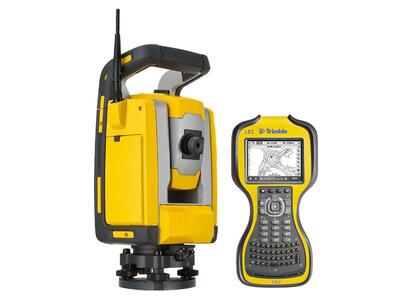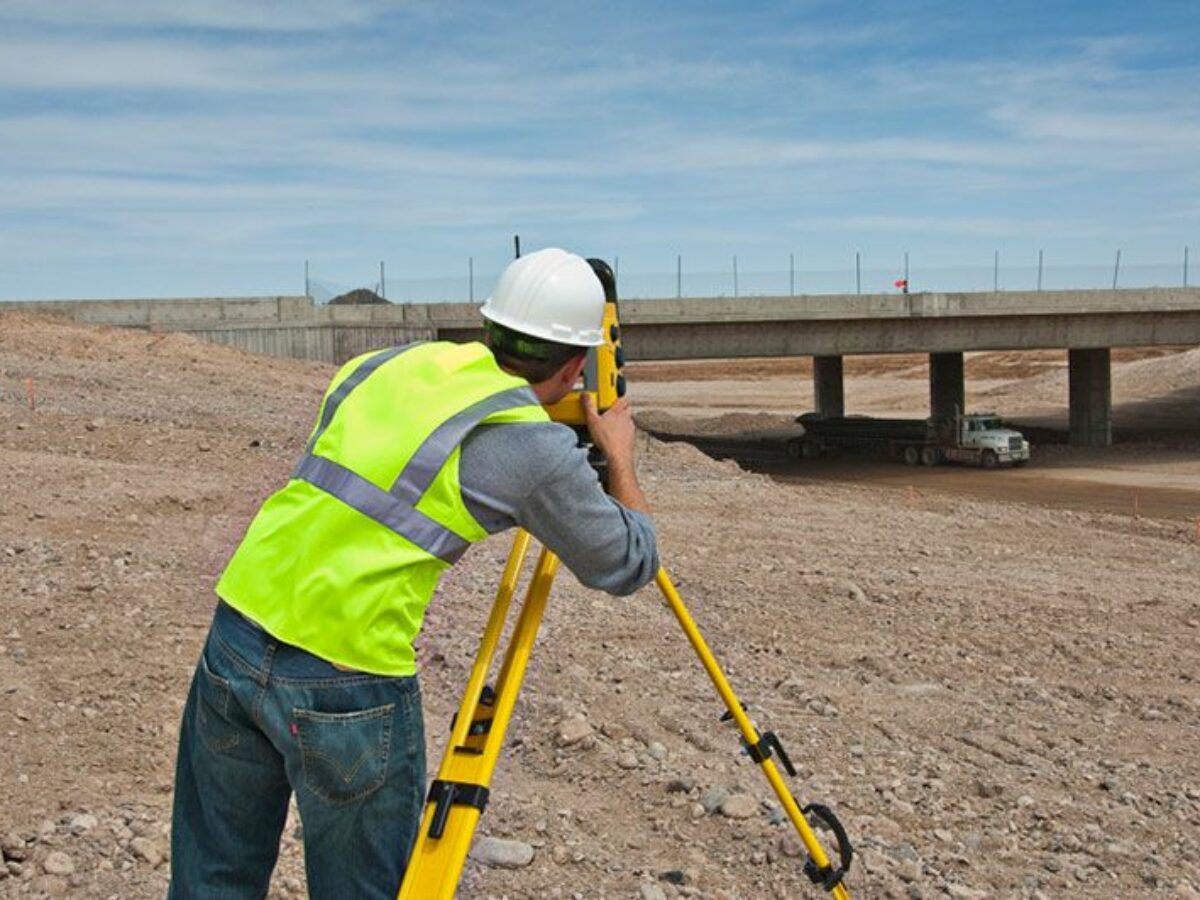Robotic total stations have revolutionised the surveying and construction industry, offering automation, precision, and increased productivity. To truly harness the power of these advanced instruments, it’s essential to understand their capabilities and implement effective techniques.
In this article, we’ll run through the many uses of robotic total stations, explore valuable tips and tricks to help you get the most out of your equipment and things to look out for when buying a robotic total station.
What is a Robotic Total Station used for?
A robotic total station is a versatile instrument used in a variety of surveying, construction, and engineering applications. Here are some common uses of robotic total stations:
Construction Layout
Robotic total stations are extensively used for construction layout tasks. They help accurately establish the positions and alignments of critical points on a construction site, such as foundation corners, columns, walls, and other key reference points. The remote control and automation features allow surveyors to operate the instrument from a distance, streamlining the layout process.
Topographic Surveys
Robotic total stations are well-suited for conducting topographic surveys, which involve mapping the contours, elevations, and features of a piece of land. They are used to measure and record multiple points across a large area, capturing detailed data for creating accurate topographic maps.
Road and Infrastructure Projects
Robotic total stations play a vital role in road and infrastructure construction projects. They are used to lay out road alignments, establish control points, measure cross-sections, and monitor the progress of earthwork operations. The ability to remotely control the instrument and set up multiple targets along the project site increases efficiency and accuracy.
Building Information Modeling (BIM)
Robotic total stations are instrumental in BIM workflows. They are used to capture precise measurements and collect data for generating 3D models of existing structures or for verifying the accuracy of constructed elements against the BIM design. The automation and accuracy of robotic total stations contribute to reliable data for BIM integration.
Monitoring and Deformation Analysis
Robotic total stations are employed for monitoring purposes in applications such as structural deformation analysis, mining operations, and environmental monitoring. They can be set up for long-term monitoring of specific points, providing continuous data on movements, shifts, or changes in structures or natural environments.
Survey Control Networks
Robotic total stations are used to establish and maintain survey control networks, which serve as a reference framework for precise positioning across a project site. By measuring and accurately locating control points, they ensure that subsequent surveying activities are based on a consistent and reliable coordinate system.
Archaeological Surveys
Robotic total stations are utilised in archaeological surveys to record precise measurements and document archaeological sites. They aid in accurately mapping and documenting the locations and positions of artefacts, structures, and archaeological features.
Environmental Surveys
Robotic total stations are used in environmental surveys to collect data for environmental monitoring, land management, and ecosystem assessments. They assist in mapping vegetation, tracking changes in land cover, and measuring terrain characteristics.
Overall, robotic total stations are versatile tools that enhance efficiency, accuracy, and productivity in a wide range of surveying and construction applications. Their automation, remote control capabilities, and advanced features make them invaluable assets for professionals in these industries.
Tips and tricks for Robotic Total Stations
Familiarise Yourself with the User Manual
Start by thoroughly reading the user manual provided by the manufacturer. Understand the features, functions, and operation of your specific robotic total station. Familiarise yourself with the control panel, menu options, and various settings. This knowledge will lay a strong foundation for using the instrument effectively.
Pre-Planning and Setup
Before heading to the field, invest time in pre-planning and preparation. Study the project requirements, review the site conditions, and identify potential challenges. Plan the setup positions strategically to optimise coverage and minimise the need for repositioning. Properly level the instrument and ensure a stable setup to maintain accuracy throughout the survey.
Utilise Remote Control Features
One of the significant advantages of robotic total stations is their remote control capabilities. Take full advantage of this feature to enhance efficiency and convenience. Use the remote control unit to operate the instrument from a distance, eliminating the need to interact with the total station physically. This allows you to focus on data collection and observation while the instrument automatically targets specific points.
Set Up Multiple Targets
When working on large-scale projects or when multiple areas need to be surveyed, consider setting up multiple targets strategically. This allows you to collect data from various locations without moving the total station. With the ability to control the instrument remotely, you can seamlessly switch between targets, saving time and effort.
Leverage Tracking Mode
Take advantage of the tracking mode available in many robotic total stations. This feature enables the instrument to automatically follow a prism or reflector target, even in motion. Tracking mode is handy when conducting surveys involving moving objects, such as monitoring construction equipment or tracking vehicles on a road project.
Optimise Data Management
Efficient data management is crucial for streamlining workflows and ensuring accuracy. Utilise software and data collection applications compatible with your robotic total station to organise and manage survey data effectively. Explore features such as automatic data recording, data logging, and export options to simplify data processing and analysis.
Regular Calibration and Maintenance
To maintain the accuracy and reliability of your robotic total station, schedule regular calibration and maintenance. Follow the manufacturer’s guidelines for calibrating the instrument, verifying angular and distance measurements, and ensuring proper alignment. Keep the total station clean and protected, and perform routine checks on its mechanical components to prolong its lifespan.
Stay Updated with Firmware and Software Updates
Manufacturers often release firmware and software updates to improve functionality, address bugs, and introduce new features. Stay informed about these updates and take advantage of them to enhance the performance and capabilities of your robotic total station. Regularly check the manufacturer’s website or subscribe to newsletters for any available updates.
By implementing these tips and tricks, you can maximise the potential of your robotic total station, improving efficiency, accuracy, and productivity in your surveying operations. Familiarise yourself with the instrument’s functionalities, plan strategically, utilise remote control features, and stay updated with calibration and maintenance.
Things to look out for when buying a Robotic Total Station
When purchasing a robotic total station, there are several important factors to consider to ensure you select the right instrument for your specific needs. Here are some key things to look out for.
Accuracy and Precision
Accuracy is a critical factor in surveying instruments. Pay attention to the angular and distance measurement accuracy specifications of the robotic total station you are considering. Look for models that offer high levels of precision to ensure reliable and accurate measurements in your surveying tasks. Each of our models has its accuracy displayed on the product page, see the Spectra Geospatial Focus 50 as an example.
Range and Tracking Capabilities
Consider the range of the robotic total station’s measurements. Choose a model that offers a suitable distance measurement range for your intended applications. Additionally, evaluate the tracking capabilities of the instrument, such as the speed and accuracy with which it can follow a moving prism or target.
Ease of Use and Interface
A user-friendly interface and intuitive controls can significantly enhance productivity and reduce the learning curve. Look for a robotic total station that offers an ergonomic design, clear display, and easy-to-navigate menu options. Consider the compatibility and ease of integration with data collection software and other surveying tools you may be using. We have so many to choose from, there is a robotic total station for every need.
Battery Life and Power Management
Assess the battery life of the robotic total station, especially if you anticipate long hours of continuous operation in the field. A longer battery life ensures extended usability without interruptions. Additionally, check if the instrument supports convenient charging options and has power-saving features to optimise battery usage. Check the FAQs on each product for more information.
Robustness and Durability
Construction and surveying environments can be challenging, with exposure to various elements. Look for a robotic total station that is built to withstand harsh conditions, including resistance to dust, water, and extreme temperatures. Robust construction and reliable sealing against environmental factors will contribute to the instrument’s longevity and reliability. All of our equipment has its durability and robustness detailed in the product manual.
Compatibility and Connectivity
Consider the compatibility of the robotic total station with other devices and software you currently use or plan to use in your workflow. Look for models that support standard data formats and offer connectivity options such as Bluetooth, USB, or wireless communication for seamless data transfer and integration.
Support and Service
Evaluate the manufacturer’s reputation for customer support and service. Ensure they provide timely technical assistance, software updates, and calibration services. Look for warranties and maintenance packages that offer comprehensive coverage and support to protect your investment. All of our equipment comes with a warranty as standard, and our testimonials are a testament to our customer service.
Budget and Value for Money
Establish a budget range based on your requirements and explore models within that range. Consider the overall value for money, weighing the features, specifications, and support provided by the manufacturer. Remember to balance your budget considerations with the quality and functionality required for your specific surveying needs. If we’ve got what you’re looking for but it doesn’t quite fit your budget, take a look at our survey equipment for hire.
By carefully considering these factors, you can make an informed decision when purchasing a robotic total station that aligns with your surveying requirements and delivers reliable and accurate results in your projects.

Robotic Total Station: Trimble SPS 720.
Get the Most Out of Your Robotic Total Station
With proper utilisation, your robotic total station will become an indispensable tool, elevating your surveying capabilities to new heights. For more on the differences between robotic vs mechanical total stations and other tips and tricks, visit our blog.
SEP are at the forefront of new technologies, developments and equipment meaning we can offer the very latest equipment in our shop including the most precise total stations. We also provide the most reliable, professional and affordable survey equipment services in the industry as we offer survey equipment repair and survey equipment hire.
